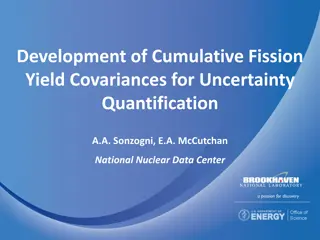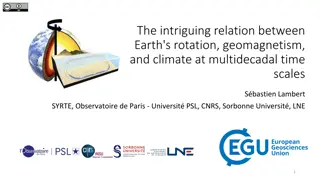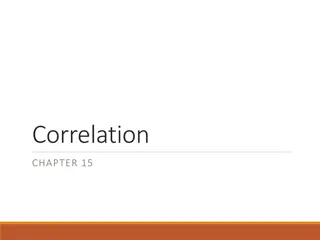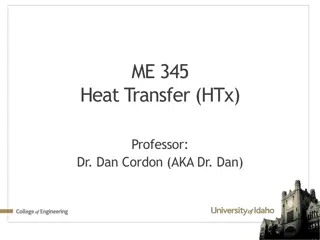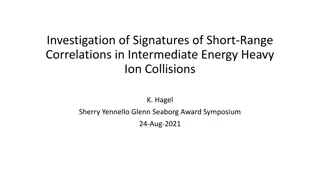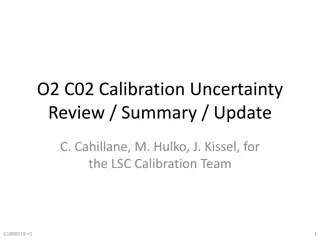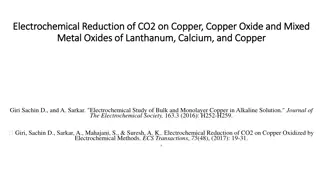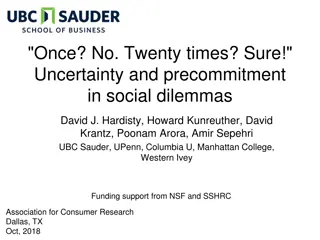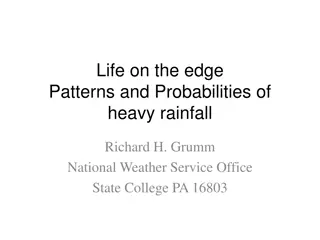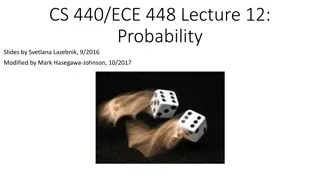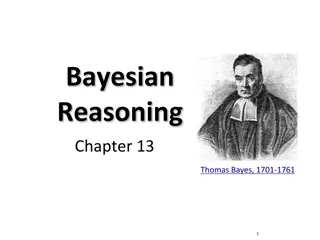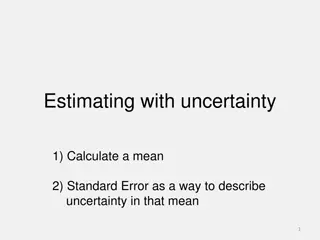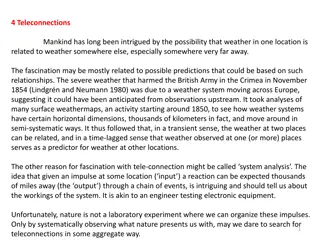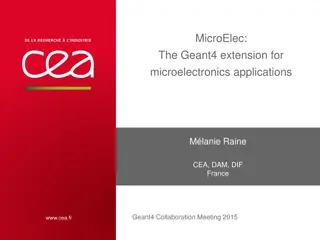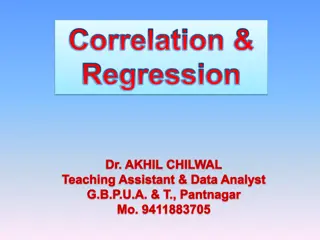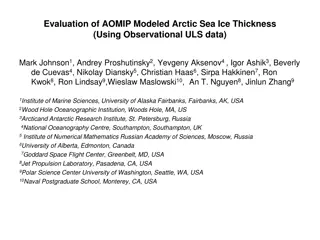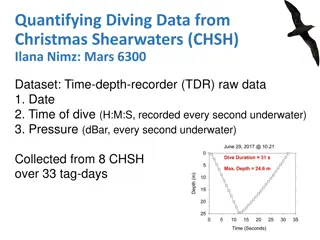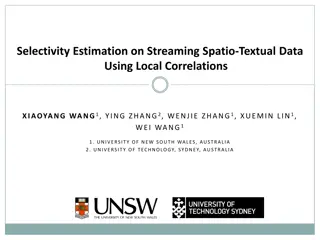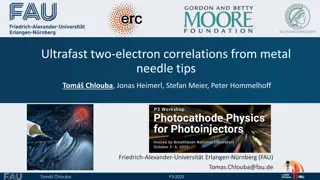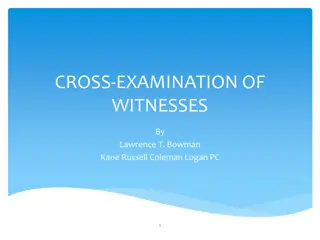Insights on Cross-Section Correlations and Uncertainty Reduction
This study focuses on the calibration and reduction of uncertainties in criticality benchmarks by analyzing integral data and correlations not present in differential data. A simplified toy model is used to examine correlations in fission, capture, inelastic, and leakage components across different benchmark spectra. Results indicate significant correlations between integral data and benchmark values, influencing the keff values. Correlation coefficients derived from Monte Carlo simulations highlight the impact on various energy ranges. This research sheds light on the complexities of nuclear benchmark analysis and the importance of considering integral data for accurate assessments.
Download Presentation

Please find below an Image/Link to download the presentation.
The content on the website is provided AS IS for your information and personal use only. It may not be sold, licensed, or shared on other websites without obtaining consent from the author. Download presentation by click this link. If you encounter any issues during the download, it is possible that the publisher has removed the file from their server.
E N D
Presentation Transcript
On Cross Section Correlations, Uncertainty Reduction and Calibration from Integral Data A.Trkov, R.Capote, O. Cabellos IAEA, Vienna, Austria ETSII/UPM Madrid, Spain
Background Current IAEA CIELO covariances based on measured differential data lead to large uncertainties in criticality benchmarks ( keff~1-2%) Small calibration of mean values have been employed to improve C/E without changing ND uncertainties Close alignment with benchmark values does not mean low uncertainty (e.g., HEU bare assemblies have a spread of ~1.5% in spite of quoted low uncertainties) Some correlations are not present in differential data, but appear only when integral data are introduced e.g., nu-bar and fission cross section Such correlations are (likely) benchmark-dependent Such correlations reduce keff
Model Consider a grossly simplified 1-group toy model of a criticality benchmark: ? ? Eq. (1): ????= ?+ ?+ ?+ ? f=fission; c=capture; i=inelastic, L=leakage Consider 3 benchmarks: Godiva Big_Ten HISS (<E>=700 keV, very hard spectrum) (<E>=40 keV, hard spectrum) (<E>=1 keV, soft intermediate spectrum)
Simple model input data Godiva 3.22379 2.59155 1.24396 0.14236 1.61269 Big_Ten 3.40604 2.48734 1.36935 0.27764 1.06276 HISS f [b] f [b] c [b] i [b] 21.43619 2.42695 8.83258 4.42019 0.55585 [%] f [%] 0.50 1.21 0.50 1.21 1.00 0.26 L keff (MC) keff (exp) [pcm] keff (exp) Cross sections averaged over benchmark spectra and the corresponding uncertainties were calculated with the RR-UNC code using e80b4 data and MCNP calculated benchmark spectra. The keff uncertainties are 2-sigma benchmark values. 0.22390 1.00027 0.68086 1.00445 7.30392 1.01533 200 140 800 1.00000 1.00455 1.00000
Simple model-based correlations (due to integral benchmark data) Correlations are derived from Monte Carlo sampled keff using Eq.(1) with the integral constrain that keff(sampled) = keff(MC) keff (exp) ).rnd where rnd is a random number in the range [-1:1] Corr. Coef. - f Total Fast Epi-Hi Epi-Lo Thermal Godiva Big_Ten -0.929 -0.928 -0.928 -0.955 -0.180 HISS -0.189 -0.306 -0.487 -0.167 -0.180 E-range Full range E[>1MeV] E[1keV:1MeV] E[1eV:1keV] Standards-2017 -0.963 -0.963 -0.963 -0.926 -0.180 Correlation coefficients are calculated with cross sections averaged over different parts of the spectrum as indicated. The thermal value is taken from Standards-2017.
Reduction in uncertainties (due to integral benchmark data) Godiva [%] 0.29 0.29 0.29 0.39 Godiva f [%] 0.51 0.49 0.52 0.64 Big_Ten [%] 0.29 0.29 0.29 0.21 Big_Ten f [%] 0.50 0.47 0.51 0.34 HISS [%] 0.46 0.27 0.49 0.46 HISS f [%] 0.15 0.64 0.52 0.13 Differential (Initial) [%] 0.50 0.50 0.50 1.00 Differential (Initial) f[%] 1.21 1.22 1.22 1.10 Energy range Total Fast Epi-Hi Epi-Lo Energy range Total Fast Epi-Hi Epi-Lo
Reduction in k_eff uncertainties Uncertainty estimates with NDaST before and after the introduction of ? - ?? correlations in U-235 k_eff Uncertainty Initial 1043 1099 649 Final 868 949 263 Godiva Big_Ten HISS
Dependence on mean values (calibration effect) The HISS benchmark has an offset of ~1500pcm in the calculated keff Calibrating keff to 1 (changing the evaluation mean values to get keff=1, while preserving uncertainties) has a minimal effect on derived uncertainties and correlations for cross sections ( adjusted ) Increasing the mean value of by 0.2% without changing the uncertainty has a similarly negligible effect on uncertainties and correlations
Dependence on mean values (HISS) +0.2% -0.188 -0.298 -0.479 -0.166 Corr. Coef. - fk-eff=1 Total Fast Epi-Hi Epi-Lo Nominal -0.189 -0.306 -0.487 -0.167 E-range -0.188 -0.298 -0.479 -0.166 Full E[>1MeV] E[1keV:1MeV] E[1eV:1keV] Differential (Initial) [%] 0.50 0.50 0.50 1.00 Differential (Initial) [%] 1.21 1.22 1.22 1.10 [%] Total Fast Epi-Hi Epi-Lo +0.2% 0.47 0.27 0.49 0.47 k-eff=1 0.47 0.27 0.49 0.47 Nominal 0.46 0.27 0.49 0.46 f [%] Total Fast Epi-Hi Epi-Lo Implicit correlations due to calibration are negligible !! +0.2% 0.15 0.64 0.52 0.13 k-eff=1 0.15 0.64 0.52 0.13 Nominal 0.15 0.64 0.52 0.13
Observations on ? to ??correlations Correlations are different for different critical systems Correlations are energy-dependent There exists some similarity between different systems Uncertainties of ? and ?? also undergo a significant reduction Uncertainties and correlations are insensitive to changes in the evaluated mean values, no implicit (hidden) correlations are observed
Conclusions Introducing correlations from considering experimental integral constrains (criticality benchmarks) may reduce the calculated uncertainties but: Correlations depends on selected benchmark Due to benchmark-dependence additional correlations (and reduced parameter uncertainties) should only be applied in derived files (Small) changes to mean values (calibrations) do not introduce correlations these are introduced only when new information is added (e.g. integral experiment data)




